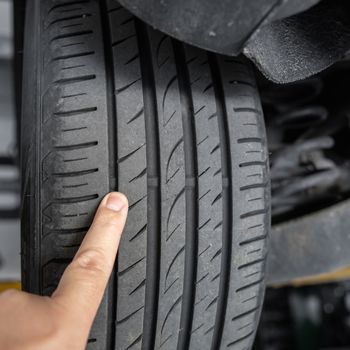 It’s expected for tires to experience wear over time. The treads thin out but if they become too shallow, this can affect your ability to stop and maneuver the car in wet and slippery conditions. Your risks for a tire blowout also increase.
It’s expected for tires to experience wear over time. The treads thin out but if they become too shallow, this can affect your ability to stop and maneuver the car in wet and slippery conditions. Your risks for a tire blowout also increase.
Although you may associate increased wear with driving more miles, the relationship is more complex. Your tires work together with the transmission, suspension and braking systems to move and stop your vehicle. Meanwhile, tire size reflects the weight and size of your vehicle to provide sufficient contact with the road and appropriate traction for control and stopping.
Generally, tire wear and tread depth are checked as part of regularly scheduled maintenance. Yet, irregular wear stemming from poor alignment and driving habits can occur, requiring you to replace your set sooner than expected. Here’s how you can reduce uneven tire wear.
Regularly Check Tire Pressure
At a minimum, aim to check the tire pressure once a month. Tires inflated below the recommended PSI for your vehicle can affect how they make contact with the road and distribute force. This can affect how well your vehicle handles and may cause you to consume more fuel.
Uneven tire pressure can emerge as:
- Central Wear: Stemming from overinflated tires, this can result in having to brake sooner, making you more vulnerable to blowouts and affecting how well your car steers.
- Outer Edge Wear: Resulting from under and overinflated tires, this can cause the edges to wear out sooner. This factor affects the sidewalls, can contribute to overheating or a blowout and impacts fuel economy.
Rotate Your Tires
When tires are not routinely rotated, they can experience more wear. In this instance, vehicle load and force get unevenly distributed and accelerate wear to the front tires. You’re advised to ask for a tire rotation every three to six months or when you go for an oil change.
Failing to rotate your tires affects how well your car steers and makes turns. You’ll also notice that you’re not able to respond as well to potholes and rough pavement. Rotating better distributes air pressure and wear, allowing you to get the most use out of your set.
Reckless Driving Habits
How you drive affects how quickly your treads show wear. Generally, driving fast through curves or above the speed limit increases the amount of wear your front tires show. Riding over potholes, especially at faster speeds, also increases wear and puncture risks. In these instances, shallower treads typically start to show along the outer edge first.
Delaying When You Change Your Tires
Neglecting to change your tires once they show shallower, worn treads further accelerates wear and increases your accident risks – especially in cold and wet conditions. In general, you’re recommended to change your tires every 30,000 miles or every five years.
Delaying a tire change can result in feathering – angled, diagonal treads on one side of the tire – as well as poor wheel alignment. Along with this visual aspect, noisy tires are an indication of feathering.
Get Your Wheels Aligned
Make sure that tire rotation also includes a wheel alignment. You can generally feel when your vehicle’s wheels are not pointing in the correct direction. Based on the angle, you’ll also spot more inner or outer wear, as well as cupping. This appears as patches of shallower, flattened treads and relates to a shock absorber or strut that needs to be replaced.
DaSilva’s Auto Body can perform regularly scheduled maintenance on your car, including tire rotation. To schedule an appointment, contact our Naugatuck shop today.




